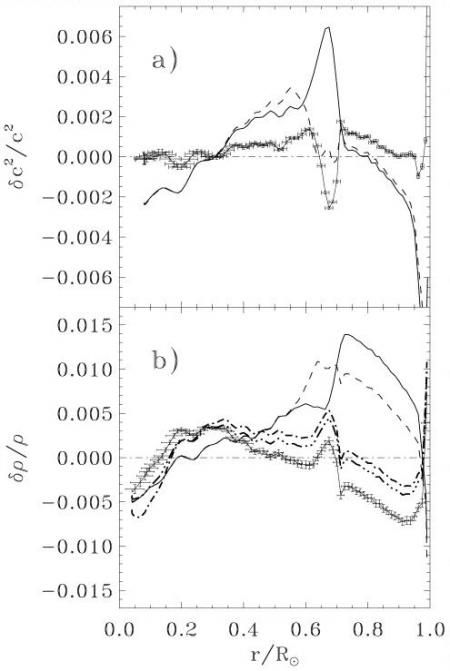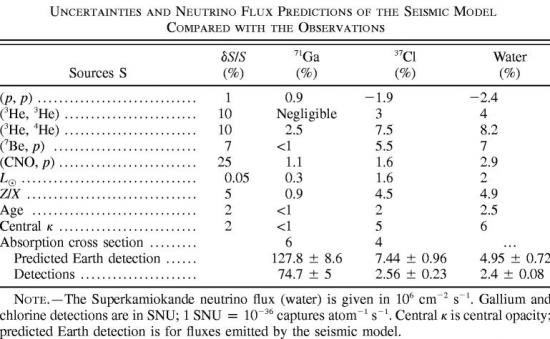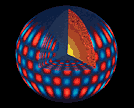On this site are available: several information, files and tables that could be useful to calculate different solutions to neutrinos oscillations. They are deduced from several papers dedicated to the solar neutrino puzzle:
Papers on models and physical processes (partial list, see other references inside):
Turck-Chièze et al. ApJ,335 (1988), 415
Turck-Chièze and Lopes, ApJ, 408 (1993), 347
Turck-Chièze et al., Phys. Rep., 230 (2-4), (1993), 57-235
Dzitko et al., ApJ, 447, (1995), 428
Turck-Chièze et al., Sol. Phys., 175, (1997), 247
Brun, Turck-Chièze and Morel, ApJ, 506, (1998), 913
Brun, Turck-Chièze, Zahn, ApJ, 525, (1999), 1032
Turck-Chièze et al., Sol. Phys., 200, (2001), 323
Turck-Chièze et al., ApJ, 555, (2001), L69
Papers on helioseismic data:
Gabriel et al., Sol. Phys., 162, (1995), 61
Scherrer et al., Sol. Phys., 162, (1995), 129
Gabriel et al., Sol. Phys., 175, (1997), 207
Kosovichev et al., Sol. Phys., 170, (1997), 43
Thiery et al;, A&A, 355, (2000), 743; Basu et al., ApJ, 535, (2000), 1078
Bertello et al, ApJ, 535, (2000), 1066
Bertello et al, ApJ, 537, (2000), L143
Garcia et al. Sol. Phys., 200, 361
Visit also the WEB sites of NASA, ESA and IAS.!
We computed a solar seismic model:
-
This seismic model has been deduced from the observations of the acoustic modes with SOHO.
-
With this satellite we can measure, using GOLF and MDI, most of the acoustic modes that penetrate more or less in the core. The recent observations of this year concern modes that are weakly influenced by the turbulent surface, so more properly determined.
-
With the seismic model, we built a model which is compatible with the seismic observations, we can then reject different suggested astrophysical solutions. We can also improve our knowledge of the solar core and reduce the error bars of the emitted neutrino predictions.
 All the details of the model will be described in a paper in preparation (Couvidat, Turck-Chièze et Kosovichev) and are summarized in the ApJ letter
All the details of the model will be described in a paper in preparation (Couvidat, Turck-Chièze et Kosovichev) and are summarized in the ApJ letter
"Solar Neutrino Emission Deduced from a Seismic Model ", Turck-Chièze et al., 2001, ApJ, 555, L69
Here we give access to our seismic modelwith a great number of shells, and also to the electron number density that is needed for the neutrino oscillations (see the observables extracted from the model).
Above is a plot that shows the relative differences between:
(a) the square of the sound speed and (b) the density deduced for the Sun using the GOLF/MDI frequencies and those of different Saclay solar models. The models are reference model (continuous curve), model Btz of Brun, Turck-Chièze, Zahn, 1999 (dashed curve), and the seismic model (curve with error bars). Superposed on the density profile are two other models: model with reaction rate of (3He,4He) reduced by 10% (dot-dot-dot-dashed curve) and model with the reaction rates of the CNO cycle reduced by 70% (dot-dashed curve) relative to the seismic model.
Below we show a table containing the different neutrino fluxes and the present uncertainties which are smaller than before:
If you want un complete table of the neutrino emissions: here is the detailed table of the neutrino fluxes
We will continue to work on the solar models for two reasons:
-
We need to improve the description of the outer layers which could also be useful for the parameters of the neutrino oscillations
-
We would like to progress on the description of the rotation and magnetic field in the convective zone, which may have some impact on the travel of neutrinos inside the Sun….
For questions or comments, you can write to: turck@cea.fr, couvidat@cea.fr
The background picture was provided by the EIT instrument aboard the SoHO satellite



